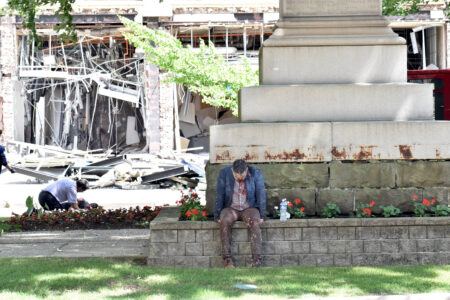Final NTSB blast report released
Faulty documentation by Dominion Energy led to Realty Tower destruction

Staff file photo / Ed Runyan A Chase bank employee covered in dust and blood took refuge beneath the Man on the Monument in Central Square in front of the Realty Tower in downtown Youngstown in the minutes after an explosion destroyed the basement and first floor of the 13-story building on May 28, 2024.
YOUNGSTOWN — The National Transportation Safety Board has released its final report on the May 28, 2024, explosion at the Realty Tower downtown, summarizing the confluence of events that led to the destruction of the 13-floor bank and 22-unit residential structure.
Its final analysis on the now-closed, 14-month investigation was that bad documentation by the natural gas company, Dominion Energy, in 2015 falsely stating that a natural-gas service line in the basement of the Realty Tower was “dead” led to a series of assumptions that took the life of Akil Drake, 27, and injured others.
“Contributing to the severity of the accident were Chase Bank’s emergency procedures that did not require employees to immediately evacuate upon being alerted to a natural gas leak,” it stated.
Nine people received treatment for injuries suffered in the explosion and aftermath, the report states. There were no customers in the bank at the time of the 2:44 p.m. explosion.
The explosion resulted in $42 million in property damage, the report states. The building was ultimately torn down, and a smallish-looking parking lot is all that is left. Drake’s family sued Enbridge/Dominion/East Ohio Gas and the owners and operators of the Realty Tower and the company doing work in the basement and received a settlement of $6.1 million with the Enbridge defendants paying $2.9 million, the Realty defendants paying $3 million and two other defendants — an engineering company and architect — paying $100,000 each.
WORKERS
The report states that workers for Greenheart, the company that was working in the basement of the building and cut the gas service line that caused the explosion, told the NTSB that “they were not aware that there was natural gas in any of the pipelines in the Realty Building basement, noting that the service line appeared old and rusty and did not have a gas meter.”
A scrap-removal crewmember stated he used a saw to cut into one of the pipes that his project supervisor had told him was inactive, or “dead,” but partway through the process, the crewmember heard a loud whistling sound and felt gas blowing into his face from the cut pipe.
The scrap-removal crew immediately exited the basement area and called 911 to report the gas leak, the report states. At about 2:39 p.m., as they exited, a crewmember pulled the fire alarm on the first floor, which alerted building residents of the emergency.
“The alarm did not sound in the building’s commercial spaces, which included Chase Bank on the first floor,” it states. Video footage showed crewmembers speaking with bank employees and pounding on the windows of the bank to notify employees of the gas leak between 2:42 and 2:43 p.m.
CHASE BANK
The video footage showed that one of the eight bank employees evacuated upon being warned about the gas leak. The other seven remained inside.
The Youngstown Fire Department received gas-odor reports from the public and notification from the Realty Tower fire alarm, just before the explosion, it states.
In accordance with building codes, the fire protection system in Chase Bank was a separate system from that of the residential building. At least one Chase Bank employee heard the residential fire alarm and left the bank to investigate the situation before returning to the building for about 2 minutes, packing up offices and alerting co-workers, it notes.
These employees were still inside at the time of the explosion about 2:44 p.m. Drake was standing near the bank’s main entrance door and was killed when the floor he was standing on collapsed into the basement space.
All but one of the apartment occupants evacuated before the explosion. Two of the bank employees sustained serious injuries, and five sustained minor injuries. One of the apartment occupants and one employee of the Doubletree By Hilton hotel across the street also sustained minor injuries.
EMERGENCY RESPONSE
The report states that at about 2:53 p.m., the incident commander from the Youngstown Fire Department asked the Enbridge natural gas company to shut off the gas service to the area, and that was done by 3:33 p.m. The incident commander first asked for Ohio Edison to turn off the power to the building at 3:06 p.m.
“About 4:19 p.m., the incident commander paused search-and-rescue operations because water was filling the Realty Building basement from a water main that had broken in the explosion, and electricity in the building was still on,” the report states.
“Ohio Edison records indicate that crews had been dispatched about 3:17 p.m. but left when they were unable to gain access to the accident scene. Ohio Edison personnel returned to the scene and shut off power about 6:25 p.m., and search and rescue operations resumed,” the report states.
Later the day of the accident, Enbridge conducted an initial pressure test of the natural gas main and service line to the Realty Building, found that it did not hold pressure and that there was a hissing noise from the pipeline in the basement that the scrap crew had cut into just before the accident, the report states.
“NTSB evaluations indicated that the accident service line was still connected to the main, and the curb valve to the accident service line was in the open position, allowing gas to flow from the main into the service line,” the NTSB report states.
When the work was being planned for the basement of the Realty Tower, Enbridge located the natural gas main and active service lines to the building and marked the ground above the lines in yellow paint, the report states. There were no yellow paint markings outside or inside the building indicating that the gas line that caused the explosion was pressurized with gas, the report states.
ENBRIDGE POLICIES
Enbridge procedures at the time that the natural gas line that caused the accident was thought have been “abandoned” years earlier and at the time of the accident, required that pipes and such must be disconnected from all “sources and supplies of gas, purged of gas, and sealed at both ends,” the report states.
But the NTSB reviewed gas company work-order records and found that the “records were inaccurate,” the report states.
“Enbridge’s work order records from 2015 indicated the curb valve (for the gas line that caused the accident) had been closed, but NTSB investigators found the valve in the open position after the accident,” the report states.
Also, although 2015 records indicated the accident service line had been disconnected from the main, the gas flowing through the pipeline after the scrap-removal crew member cut into it, as well as a post-accident pressure test, indicated that the service line was still connected to the gas system and contained natural gas, the report states.
The gas company’s procedures for “abandoning” a gas service line such as the one that caused the accident required gas curb valves to be “removed or closed and service lines to be disconnected as close to the (gas) main as possible. The procedure did not include a requirement for the work crew to visually confirm the service line was disconnected from the main before processing the service line cut order,” the report states.
Gas company representatives went to the Realty Tower to mark active gas lines in the building in January and May of 2024, but they were not aware of the gas line that caused the accident, only the gas main and active service line in the building, the report states.
In a “Lessons Learned” section of the NTSB report, the agency reported on steps that were taken to avoid the mishap of a gas service line not being properly identified as an active service line.
One step was the Public Utilities Commission of Ohio overseeing Enbridge’s excavation of 10 natural gas service lines that had been documented as abandoned around the same time as the accident service line from the Realty Tower, the report states.
Enbridge found that two of the lines were still pressurized with gas. Enbridge also reported that it was investigating 5,951 other pipelines that were documented as abandoned but whose records contained inconsistent or unconfirmed data.
The company found that 79 of those pipelines were active. Enbridge later properly abandoned them according to the new procedure and updated their corresponding records, the report states.
In August 2024, Enbridge issued a pipeline safety alert advising crews about a revised practice for disconnecting and abandoning service lines. According to the revised practice, before completing a service line cut order, the pipeline must be exposed for visual confirmation that the service line has been effectively cut from the main and capped off, the report states.
Training materials have been updated to reinforce the revised practice. Enbridge also is installing warning tags on their interior natural gas pipes to alert customers of the presence of pressurized gas and how to contact the gas company, the report states.
BANK, POWER COMPANY
After the accident, Chase Bank revised its emergency guidelines and employee training to require immediate evacuation during incidents involving gas leaks, the report states.
Ohio Edison also revised its training courses for employees on emergencies to “reiterate the importance of coordinating and communicating with” incident commanders to facilitate a timely response.
The NTSB’s official probable cause statement for the explosion was listed as “a cut by a scrap-removal crew into an active Enbridge Inc. service line, which was incorrectly documented as having been abandoned years earlier by the pipeline owner at the time, Dominion Energy Inc., and which allowed natural gas to leak into the Realty Building where it was ignited by an unknown source. Contributing to the severity of the accident were Chase Bank’s emergency procedures that did not require employees to immediately evacuate upon being alerted to a natural gas leak.”



